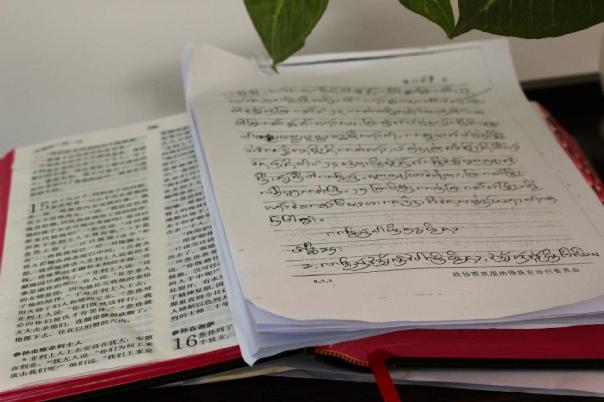My friend, Mihee, writes a wonderful blog called First Day Walking, and she’s been so gracious to feature an essay I wrote on Centering Prayer for her Merely Beloved series on Spiritual Disciplines. You can click over and read my essay here, or scroll down, and if you’re just joining us from Mihee’s blog, welcome, welcome, welcome!
If you’re wanting to learn more about my practice of centering prayer, there’s a whole slew of posts here. Also feel free to hunt around the blog and get to know me: my Two Years in China post has some highlights of what I’ve been up to these past few years and lately I’ve been blogging about reentry to life here in the United States and the people I love and miss in China. Please leave your mark in the form of comments: I’d love to get to know you!
I remember vividly that my love affair with centering prayer began in my senior year of college.
I was pursuing a call to ministry, poised to move first to Puerto Rico and then onto Washington, DC to serve the poor, and becoming exhausted with finding myself betwixt and between empty praise and worship and stodgy skepticism. I longed for a place where the presence of God, not our wanton human wisdom, was paramount.

Somehow I found my way to the little Catholic circle on my Presbyterian campus, a motley crew led by a renegade lady who didn’t seem to think it weird that everybody called her Pastor and who was convinced that service and contemplation went together. In the little workshop in which she roped me in, she taught us the ins and outs of lectio, the intentional listening for God while reading scripture (in contrast to the very real Bible school temptation to try to unravel the whole meaning of the verses in just a few minutes).

We were reading Ephesians 3:14-18, incidentally one of my favorite passages since youth, closing our eyes and earnestly seeking God, and then going around and sharing the words or the phrases that stuck out to us. When the Pastor got to me, I shared my word, “grasp,” only she revealed to me that that word wasn’t actually in the text for today.
“Don’t worry,” she said, “that happens frequently,” with a smirk and a chuckle, and I was awestruck by how nonchalant this Catholic woman could be about minor miracles in our midst.
It turns out that repeatedly hearing the NIV version of that scripture growing up probably put that word in my head, but maybe God wanted me to hear it, too. When I began to come to the Catholic circle with regularity, where they not only closed their eyes and listened to scripture with their hearts, but sat for thirty minute silent prayer sessions, I also began to use grasp as my prayer word, to which I could return my heart, as I did with my eyes to the candle burning in the center of the room, if my mind wandered.
Pastor Barb, despite her high energy and her electric personality, had this ease about her, this sense that prayer was about so much more than words, and that communion with God was meaningful even when it didn’t feel like anything, even when nothing happens.
As far as my own life is concerned, the mystery of centering prayer seems to be just as much about what happens outside of the prayer as in it. During nearly six years of practicing centering prayer in the barrios of Puerto Rico, in our nation’s capital, and on the campus of Princeton Theological Seminary, that word grasp took me on a journey from grasping for God, to realizing that God has been ever and always grasping for me.
Shortly after moving to China, I felt compelled to choose a new prayer word, and whereas grasp at least implied God’s action, if not my own, the word to which I was led, abide, seemed to denote the essence of passivity.

But as I’ve lived and breathed and been silent with it a bit more (and trust me, silence was something I craved in a city of nearly 7 million!), and as life in China unfolded to show me that not only is control merely an illusion, but that God is also greater and more faithful than I ever imagined, I realized that abiding is quintessentially the opposite of distraction, and centering prayer not only the art of intention, but the willingness to let God lead the way.
As J. David Muyskens writes in an eloquent little book on the topic,
“Maybe I am getting in best when nothing happens. Maybe I am on to something when there is no reward for me. Maybe the closest I can be to awareness of holy is just to be with the mysterious attraction that the Creator put in me. And, maybe when I don’t even sense that, still the transforming work of Christ goes on, unknown to me. Maybe that’s just the point: no effort on my part, only divine action.”
—Sacred Breath: Forty Days of Centering Prayer, p. 87

Maybe the reason lectio and centering prayer have been so profound throughout the ages (some say they date back to the Desert Fathers, at least to the Benedictine monastics, and amazing people of faith like Teresa of Avila, John of the Cross, and modern-day monks in American Catholicism like Thomas Keating) is because they’re not just a different way of praying, but the opposite of what we as human beings would normally do. We’ve been trained, in the West, if not hard-wired, to dive into scripture and faith and religion with our minds. As an M. Div grad and a Ph.D student, I especially struggle with the mind’s endless critiquing, probing, meandering, and if you will, having a mind of its own!
But what’s active in centering prayer is explicitly not the mind–the mind’s to be quieted to allow for the Spirit to grow, reside, and even meander. My discipline has changed as I’ve grown. Whereas earlier on, I was very conscious of clearing the mind and letting go of all thoughts, I’ve become less legalistic and more open to some of the lingering, nagging voices that exhibit themselves in that silence, more open to the myriad manifestations of God’s presence.

I’ve closed my eyes in just about every fabulous place I’ve ever had the privilege of traveling to. But I’ve never regretted those moments of silence, nor have I ever been really alone. You see, doing centering prayer in community way back in my college days always made sense to me. It’s not an easy thing to commit to those fifteen or thirty minutes on your own, but with safety in numbers, it’s somehow easier to open up to God fully and freely.
At Princeton Seminary, we’d sit in my crowded dorm room and attempt to block out the stress and the theology and the gods we often worshipped to welcome God in a very intentional way. And in China, my dear friend joined me over skype, across an ocean, and a twelve-hour time difference, and yet the practice couldn’t have been more fruitful. She says that after all these years, because we both still have a hard time with silence, it sometimes helps her to look up and see my peaceful face, the ups and downs of the breaths in and out of my chest, and my eyes closed, and and I feel the same way.
Believe it or not, silent prayer isn’t meant to be a solitary, distant practice. As Pastor Barb made clear back in the day with her penchant for social action, it’s meant to take us from detachment, to intention, to communion with God, and into community. I know it sounds impossible, bogus, even, that a practice of silence and contemplation would awaken Christians to community, to love and to justice. And I know it’s not for everyone, my own husband doesn’t take refuge in silence the way I do, and I think that just speaks even more clearly to God’s myriad of manifestations.

This one, this discipline, is not for everyone. But if you’ve ever struggled to hear God above all the other voices, if you’ve ever lost touch with your heart or your spirit, or wondered about the work of the Holy Spirit, you may want to start closing your eyes and listening to your breath, reading scripture with the eyes of your heart, seeking communion rather than answers, and being open to God’s presence not just in these times of silence but everywhere in the world.
For further resources on the discipline of centering prayer, consult J. David Muyskens’ Forty Days to a Closer Walk with God, Sacred Breath, or Richard Rohr’s Simplicity for more on contemplative action.